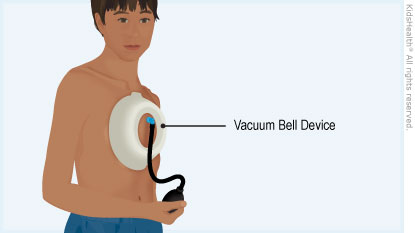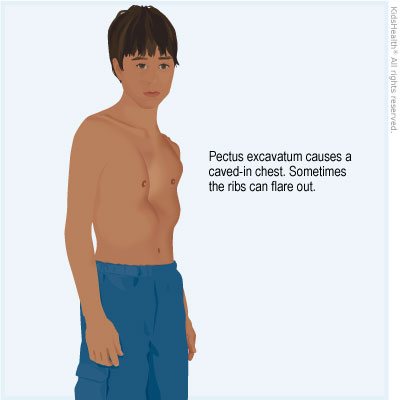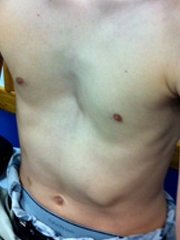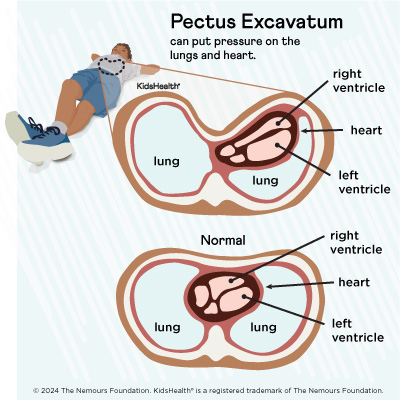pectus excavatum baby symptoms
Fast heart rate tachycardia. It is one of the most common deformities that also affects women.
While most patients do not have symptoms those with severe forms of the abnormality may experience.

. Chest CT reconstruction of young woman with left sided pectus carinatum red arrows and mild rib flare on left blue arrows and some rib flattening green arrow Bilateral rib flare showing a right sided costal arch with a dip or deficit arrow in green where the lower costal arch has not formed completely. Even though kids who have pectus excavatum are born with it it might not be noticed in the first few years of life. You may see a small dent in your childs chest when they are of grade school age.
It occurs mostly in boys and frequently more members in a family are affected. The condition can be mild or severe. Pneumothorax air around the lung.
Pectus excavatum is usually noticeable soon after birth. Some children with pectus excavatum also have other medical conditions or bone abnormalities. What are the symptoms.
Problems tolerating exercise limitations with some kinds of physical activities tiredness chest pain a rapid heartbeat or heart. Pectus excavatum is characterized by an abnormality that gives the chest a caved-in or sunken look. A hollow depression in the chest that may be broad and shallow deep and narrow or irregular.
Pectus excavatum does not always cause other symptoms especially before the teen years. Symptoms may only start when the child is older and they may get worse with age. One of the symptoms may be if your baby is crying very often for no particular reason.
Symptoms of heartburn and GERD are a burning feeling in the chest throat or mouth nausea and more. The deformity can be recognized in women directly after birth or during the adolescent period. Some children with funnel chest may not experience any symptoms except the shape of their chest.
Pectus excavatum affects about one in 1000 children and is four times as common in boys as in girls. Pectus excavatum a deformity of the sternum and ribs caused by an unbalanced costochondral hypertrophy is a congenital abnormality with a prevalence of 1 per 1000 patients. It can also develop in a baby after birth.
Those with moderate-to-severe condition may have symptoms such as shortness of breath fatigue exercise intolerancelimitations and chest pain. One of the most obvious examples of a side-effect of pectus excavatum is shortness of breath and difficulty in breathing. Shortness of breath with.
Those with a mild condition often do not have symptoms. Pectus excavatum occurs in a baby who is developing in the womb. Chest pain andor shortness of breath especially while exercising.
It can also develop in a baby after birth. Shortness of breath upon exertion or exercise. In older children symptoms of pectus excavatum can include.
Moderate-to-severe cases can cause. The main sign of pectus excavatum is a chest that looks sunken in. Pleural effusion fluid around the lung.
Ribcage problems do not usually cause problems when the heart and lungs are developing but rarely can affect how well they work in later childhood. This occurs because the sunken shape of your childs breastbone can put pressure on the lungs. 1 2 Pectus excavatum may be associated with connective tissue disorders such as Marfan and.
Esophagitis an inflammation of the lining of the esophagus causes chest pain nausea and more. Older children may develop issues involving self-image or self-confidence. But this deformity happens five times less commonly in females than in males.
The cause of the disorder is not known. Both or just one side of the breastbone may be affected. Possible complications from surgical repair of pectus excavatum include.
Marfan syndrome connective tissue disease Noonan syndrome disorder that causes many parts of the body to develop abnormally Poland syndrome disorder that causes muscles to not develop fully or at all Rickets softening and weakening of the bones Scoliosis abnormal curving of the spine. More rapid breathing than normal. Pectus excavatum is due to too much growth of the connective tissue that joins the ribs to the breastbone.
Another sign for parents is coughing. In infancy symptoms of pectus excavatum can include. In the most severe cases the breastbone can also put pressure on the heart so that it cannot pump blood correctly.
Pectus excavatum occurs in a baby who is developing in the womb. Pectus Excavatum and Pregnancy. This is one that I noticed myself very prominently when carrying out even mild exercise as it can be brought on from as little as going for a walk or climbing a staircase.
As the ribcage is more rigid than normal it can make it difficult to completely breathe out expire. Studies have shown that pectus excavatum in babies can also cause respiratory infections. Pectus excavatum recurrence comes back after the bar is.
Often it gets worse at about the time a child starts puberty age 12 to 14 years. Pectus excavatum is a type of birth defect that causes the chest to look caved in or sunken. Many cases are found in the early teenage years.
Pectus excavatum may also be associated with scoliosis in some. That can be caused by a hard pushing of the breastbone into the lungs. What causes pectus excavatum.
The crying is closely related to chest bone pain which is one of the most common signs of pectus excavatum. Pectus excavatum can range from mild to severe and your child may or may not have symptoms related to the heart or lungs. Pectus excavatum baby causes.
Others may experience symptoms including. With a severe case of pectus excavatum there can be compression of the heart. Symptoms of Pectus Excavatum.

Chest Deformation Disorder Type Pectus Excavatum Marfan Syndrome Sign And Symptoms Stock Illustration Download Image Now Istock

Should I Worry If My Child S Chest Is Sunken Cincinnati Children S Blog

Features Of Rickets Such A Frontal Bossing Harrison Sulcus Pectus Download Scientific Diagram

Nuss Procedure For Pectus Excavatum Background Indications Contraindications

Pectus Excavatum Symptoms Treatments And Complications

Pectus Excavatum From A Pediatric Surgeon S Perspective Abstract Europe Pmc

Pectus Excavatum A Case Study The Journal For Nurse Practitioners

Chest Wall Disorder Pectus Excavatum For Parents Primary Children S Hospital

Help My Baby S Chest Is Caving In Pectus Excavatum Dr Paul Youtube

Kidshealth Pectus Excavatum Vacuum Bell Device Akron Children S Hospital

Pectus Excavatum Children S Hospital Of Philadelphia

Patient 2 Note Cafe Au Lait Spots Pectus Excavatum Widespaced Download Scientific Diagram

Chest Wall Disorder Pectus Excavatum For Parents Norton Children S
How To Deal With Your Child S Pectus Carinatum Condition Align Clinic

Pectus Excavatum Information Mount Sinai New York

Pectus Excavatum Chest Wall Stanford Children S Health

Pectus Excavatum Symptoms Treatments And Complications

Pdf Prenatal Diagnosis Of Pectus Excavatum

A Proband At 3 Years Of Age With Pectus Excavatum Relatively Short Download Scientific Diagram
/GettyImages-955109626-4b3292cc1af6404d8e85bd1145bd1193.jpg)